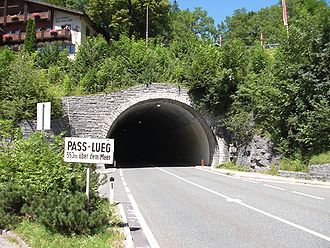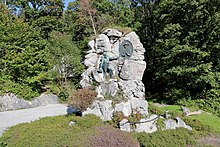Pass Lueg
| Pass Lueg ( valley pass ) |
|||
|---|---|---|---|
|
Pass with sign |
|||
| Compass direction | North | south | |
| height | 552 m above sea level A. | ||
| state | Salzburg , Austria | ||
| Waters | Salzach | ||
| Valley locations | Golling on the Salzach | Tenneck | |
| expansion | Salzachtal Strasse (B 159) | ||
| Mountains | Hagengebirge / Tennengebirge | ||
| Map (Salzburg) | |||
|
|
|||
| Coordinates | 47 ° 34 '32 " N , 13 ° 11' 41" E | ||
The Pass Lueg (pronounced "Lu-eg" with an emphasis on the first syllable, but ethymologically correct but "Luag") is a 552 m high valley pass in the Alps on the Salzach , in the state of Salzburg ( Austria ). It used to be the most important connection between the outer mountains and the inner mountains , the country's mountain regions , and was part of one of the most important Alpine transit routes , but has largely lost its importance today. The few buildings also form a district of Golling an der Salzach .
Word origin and name
1160 is a tollgate APED clusam iuxta Weruen (in the cell close to throw ') mentioned, the later can Hohenwerfen be well as the pass-resistant Lueg (or simply the whole passage). Luoch is mentioned in the 13th century (1258, 1291). The part of the name Lueg is probably derived from the word lie (pronounced Luagen), i.e. H. of look. A good view of the Tennengau is possible from parts of the Lueg Pass. The syllable <ue> in Lueg (with an emphasis on the <u>) is not the umlaut <ü>, but the old Bavarian paraphrase for the diphthong <ua> (see also Upper German writing language ). The correct pronunciation would therefore be Pass Luag or Pass Luug . The former variant is still mainly used in dialect today, with the <a> often indistinct and disappearing into a Schwa . In the general colloquial language, the pronunciation according to the spelling Lueg is common.
The two terms Pass Lueg and Salzachöfen can be used interchangeably for the entire gorge-like valley of the Salzach, in a narrower sense the Pass Lueg is a location and historical fortification in the middle of the gorge, and the Salzachöfen are the lowest and wildest section of the Salzach.
The part of the road is called “pass” because it actually climbs almost 100 meters from the Salzach level in order to pass the most impassable places.
geography

The valley pass is located south of Golling an der Salzach in the gorge-like breakthrough of the Salzach through the Hagen Mountains in the west and the Tennen Mountains in the east. To the north of the pass are the whirlpool holes of the Salzachöfen . In parlance, the expression means both the top of the pass in particular, as well as the entire S-shaped valley section, from the Salzachöfen and the exit of the Salzach from the Alps in the north to the south-facing beginning of the gorge, at the old Stegenwald trucking and rafting inn ⊙ .
Only the Salzachtal Straße (B 159) runs over the Lueg Pass . The Tauern Autobahn (A 10), which runs parallel to the B 159, leads through large tunnels, the Ofenauer Tunnel (1.3 km), a Salzach bridge and the Hieflertunnel (2 km) due to the narrowness of the local valley section . The Salzburg-Tiroler-Bahn , the Salzburg-Bischofshofen railway line and beyond, does not go over the top of the pass itself, but bypasses it with a bridge and the Ofenau tunnel (940 m) a little before the pass itself. The rest of the Salzachengstelle leads south but along the Salzach and accompanies the B 159.
Today the motorway also has a junction at Pass Lueg near Stegenwald (Exit 34).
history


The Pass Lueg is undoubtedly an old road , an important evidence is a deposit from the Bronze Age, which dates back to the 13th century BC. Its most important find is the helmet from the Pass Lueg , an Etruscan crested helmet . It was found in 1838. Also in 1972 wagon tracks on the important Norian Roman road Aquileia - Virunum - Iuvavum (from the Adriatic via Lower Carinthia and the Radstädter Tauern to Salzburg and the Limes) were found on the section between the Mansios (post stations) Vocarium ( village throwing ) and Cucullae ( Kuchl ). The pass has retained its importance as a transport route of European importance until recently.
The fortification of Pass Lueg was expanded by the Salzburg prince archbishops in the course of early modern times . Here in the 4th Napoleonic War in 1809, the Salzburg freedom fighters under the rifle captain Josef Struber successfully opposed the French-Bavarian troops. Salzburg, at that time already a Habsburg electorate , was nevertheless taken by Napoleon's troops and Struber handed over the passport after the peace treaty on October 20th. As a result, the state briefly belonged to Bavaria.
In the 1870s, the Kaiserin-Elisabeth-Bahn (Salzburg-Tiroler-Bahn) , also known as the Westbahn , was built with the Ofenauer Tunnel , which bypasses the narrowest part of the Lueg Pass.
On the night of June 9th to 10th, 1934, a month before the July coup, Johann Leirich, a volunteer from the Salzburg Homeland Security, a sub-organization of the Heimwehr , was murdered by illegal National Socialists infiltrating from Germany. His colleague Otto Repas was shot. The later SS member Konrad Strasser from Golling was suspected as the perpetrator. However, an Austrian extradition request was ignored by the Nazi judiciary. After the annexation of Austria, the suspect was amnestied by the Law on Exemption from Punishment of April 30, 1938. After the Second World War, the crime was not pursued, as Strasser was believed to have fallen in the Berlin area in 1945 and was declared dead.
In February 1950, the former US military attaché in Bucharest , Navy Captain Eugene Simon Karpe , was found dead in the railway tunnel under the Lueg Pass . Investigations revealed that he was traveling from Vienna to Paris, was forcibly pushed out of the Arlberg-Orient-Express and was run over by the train in the tunnel. Eastern secret services were blamed for the crime, as Karpe was a close acquaintance of the American businessman Robert A. Vogeler, who had been sentenced to 15 years imprisonment in communist Hungary for espionage. Before leaving Vienna, Captain Karpe had visited Vogeler's wife. However, the fact could never be solved. Karpe was buried in the United States at Arlington National Cemetery .
In the 1970s, the legendary guest worker route Western Europe - Balkans led over the pass , with enormous traffic and traffic jams, which was only brought under control with the construction of the Tauern Autobahn . The Golling - Pass Lueg section ( Ofenauertunnel / Hieflertunnel , junction Pass Lueg near Stegenwald ) was opened in 1974, the further section to Werfen / Pfarrwerfen in 1977. Since then, the pass itself has only been of local and tourist importance.
Attractions
- Fortification of Pass Lueg , documented as a toll station in 1160, today baroque to Napoleonic
- Chapel of Our Lady Maria Bruneck , small baroque church (around 1760)
- Struber monument , in honor of the rifle captain Josef Struber and the battle of 1809
- War memorial of the First World War
- Salzachöfen , gorge of the Salzach (natural monument)
- Croatian cave , natural cave with fortifications (a little upstream on the other side, accessible via a footbridge, is also a listed building, cave itself not public)
Web links
Individual evidence
-
↑ ÜB Salzbg 2 No. 350, information in Isolde Hausner; Austrian Academy of Sciences - Commission for Dialectology and Name Research (Ed.): Old German name book: the tradition of place names in Austria and South Tyrol from the beginnings to 1200 , part 14, publishing house of the Austrian Academy of Sciences, 1989, p. 1117;
Hohenwerfen was built in the 1070s. -
↑ Today in the Salzburg Museum .
Fritz Moosleitner: The helmet from Pass Lueg in the Salzburg Museum Carolino Augusteum . In: Salzburger Museumsblätter Vol. 43, 1982, pp. 5-6.
Gerlinde Proier: "The helmet from Pass Lueg". A precious find in the Salzburg Museum Carolino Augusteum. In: Österreichische Ärztezeitung Vol. 37, 7, 1982, pp. 470–471.
Helmet from Pass Lueg . In: Salzburger Nachrichten: Salzburgwiki . - ↑ Road tracks sunk into the rock south of the pass and below the Maria Brunneck church, 8 m below the current lane of the B159; Information by Martin Hell: Traces of old roads at Pass Lueg. In: Archaeologia austriaca 51, 1972, pp. 97-103.
- ↑ Der Spiegel: Shots at the Pass , issue 11/1980.
- ↑ Der Spiegel: Kommando Kranzschleife , issue 34/1981
- Jump up ↑ Arlington National Cemetery: Eugene Simon Karpe - Captain, United States Navy
- ↑ Autobahn and Schnellstraßen-Finanz-Aktiengesellschaft (Ed.): The autobahn network in Austria. 30 years of Asfinag . Self-published, Vienna / Absam January 2012, A 10 Tauern Autobahn , p. 84 ( pdf , asfinag.at). pdf ( Memento of the original from January 1, 2015 in the Internet Archive ) Info: The archive link was inserted automatically and has not yet been checked. Please check the original and archive link according to the instructions and then remove this notice.




